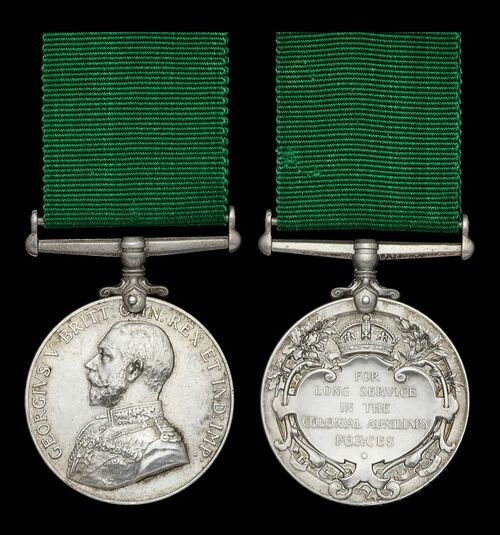
Auction: 24111 - Orders, Decorations and Medals - e-Auction
Lot: 843
(x) The Colonial Auxiliary Forces Long Service to Lieutenant L. Dadson, Australian Imperial Force, a native Tasmanian who won the Military Cross three times during the Great War
Colonial Auxiliary Forces Long Service G.V.R. (Lieutenant L. Dadson M.C.) impressed suspension slightly slack, otherwise very fine
[M.C.] London Gazette 20 June 1917, the original citation states:
'For conspicuous gallantry and devotion to duty. He led two platoons with great ability in the face of heavy fire, capturing the position and two machine guns. His personal bravery was largely responsible for the success of the operation.'[First Bar to the M.C.] Edinburgh Gazette 18 June 1917, the original citation states:
'For conspicuous gallantry and devotion to duty. he took a small party forward and formed a protecting flank, personally directing their fire. Although hard pressed by weight of numbers, he stood his ground and succeeded in driving the enemy back. he showed a fine example of tenacity and pluck.'
[Second Bar to the M.C.] Edinburgh Gazette 5 February 1919, the original recommendation states:
'For conspicuous gallantry near Lihons on 11th August 1918, while in command of his company in conducting the attack on a very strong enemy position in Auger Wood which was full of machine guns. He carried the position with a rush, thus facilitating the advance in other parts of the line. His excellent leadership resulted in his company capturing 15 machine guns, accounting for the teams in every case, and taking three field guns. He did splendid work.'
Leslie Dadson was born on 6 March 1884 at Sidmouth, Launceston, Tasmania. He was educated at Bangor State School and took up farming and served with the militia units for 9 years attaining the rank of Sergeant. Enlisting with the 12th Battalion, 3rd Infantry Brigade of the Australian Imperial Force on 25 August 1914 and embarked in the Geelong on 20 October. Promoted to Corporal on 9 February 1915 while serving in Egypt, the battalion later landed at Gallipoli on 25 April 1915 and was further promoted to Sergeant on 12 May. He led a platoon at Lone Pine and was wounded, during his convalescence in hospital at Alexandria he was appointed Second Lieutenant.
Upon leaving Gallipoli he remained with the 12th and was sent to the Western Front taking part in various actions throughout 1916. He was promoted to Lieutenant on 25 May 1916.
On 9 April 1917 the battalion attacked in the village of Boursies, which screened the Hindenburg line. Dadson led forward two platoons under heavy fire and captured two machine-guns; his bravery and initiative won him the Military Cross. On 15 April the enemy counter-attacked at Lagnicourt where he commanded the 'B' Company. He took a small party forward to form a defensive flank and, through hard pressed, refused to abandon his position, while narrowly escaping capture; he won a Bar to the M.C. for his fine example of tenacity and pluck.
After eight months as an Instructor with a training unit, Dadson returned to his battalion in March 1918 and on 10 May was wounded in action. On 11 August the enemy line in the Lihons vicinity, near Auger and Crepey Woods, was heavily defended, but Dadson's company, led with great dash and courage, captured fifteen machine-guns and three field pieces. Commended for his conspicuous gallantry and devotion to duty, he was awarded the rare distinction of a second Bar to the M.C. He sailed for Australia on 13 October with other 1914 men on 'Anzac leave'. On 23 February 1919 his A.I.F. appointment was terminated, though he continued militia service until country units were disbanded in 1924; in 1928 he was awarded the Volunteer Officers' Decoration.
Dadson returned to his farm at Bangor and in 1922 was appointed inspector to the Closer Settlement Board. He was the first president of the local sub-branch of the Returned Sailors' and Soldiers' Imperial League of Australia, and in 1921-24 was on the Lilydale Municipal Council. On 30 October 1923, he married Margaret Ann Vaughan of Oswestry, England. Dadson became a J.P. in 1943 and was employed by the Agricultural Bank of Tasmania, retiring in 1950 and died on 5 May 1961.
Subject to 5% tax on Hammer Price in addition to 20% VAT on Buyer’s Premium.
Estimate
£200 to £300
Starting price
£140




